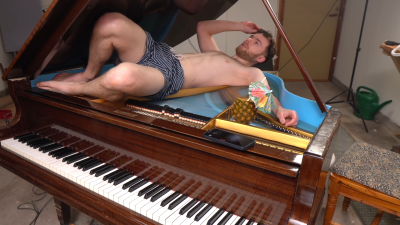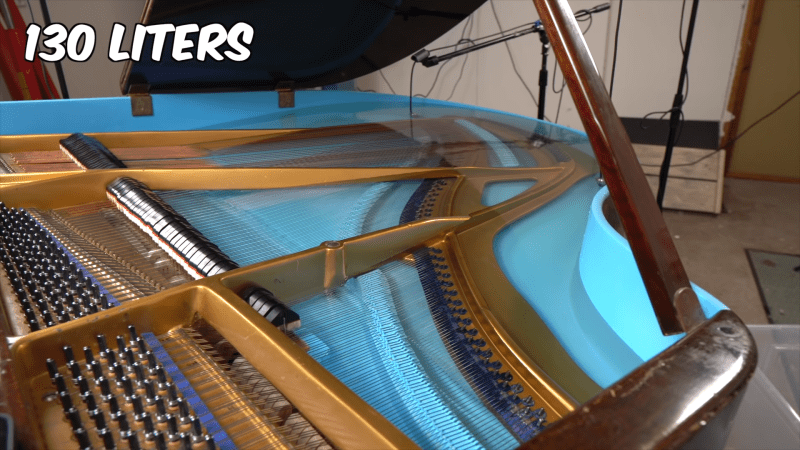Filling a piano with water probably sounds frivolous and asinine to many. However, it also sparks a certain curiosity as to what it would be like. Thankfully, [Mattias] put in the hours of work to find out so we don’t have to!

A first attempt with an upright piano failed quickly. After just four minutes submerged in water, the wooden hammers would seize up as they swelled with moisture.
A grand piano was sourced for a second attempt. The strings were first detensioned to make things easier to work with, and the internal frame pried out from the surrounding piano body. To stop the water pouring out past the keys and strings, a simple solution was implemented: tilting the piano up so the water remained in the body below. A judicious application of various sealing agents was then used to seal the frame. Amazingly, the best information on sealing a piano came from enthusiasts building aquariums out of plywood boxes. Go figure.
The water has a muting effect on the piano’s sound as you might expect. The sound is particularly compelling when heard via underwater mics placed in the water-filled cavity. It almost sounds like a plucked instrument, and gives everything a strangely maritime feel. The sound waves can be seen on the surface of the water, too.
The experiment came to a tragic end when the piano was overfilled, dumping water over the keys and hammers. This caused every key to jam, killing the piano for good.
It’s a fun build, and a very silly one, if you can stand to watch a piano treated in this way. [Mattias] has form in the area of oddball instrument hacks, too, as we’ve previously featured his helium guitar. Video after the break.

















That just sounds like a thinly veiled excuse to get YouTube views.
That took lots of work and experimentation, and some creativity to pull off. It’s a shame it couldn’t take the final beating at the end, but I don’t think he thought it would ruin it that badly.
Still, it’s a good example for anyone to learn they should try to hack their ideas together and see if they work, even if it doesn’t work very well in the end.
When he replaced the felt hammers on an upright piano with metal hammers, Impact Soundworks paid Mattias to digitally record every note in several different ways so they could create the Hammerklavier plugin for the Kontakt player. https://impactsoundworks.com/product/hammerklavier/ I assume Mattias gets a cut of the sales.
Rumor has it they’re going to fund a better underwater piano to be digitized.
It’s too bad that it’s impossible to keep fishing line in tune on a piano for very long because that had a very different sound. Metal guitar strings also had a unique sound but to do it right a custom set would have to be made to be long enough. Piano strings on a guitar didn’t work very well.
But I have played a pawnshop electric bass that had piano strings (of appropriate gauge) on it, played well even through an amp (apparently they were bronze wrapped steel strings)
Not advisable… but then again Burton Cummings talked about giving both his hands, not a handy thing to do for a pianist unless you’ve perfected playing the piano with your toes first.
Yep, good one WordPress… buggerise around with log-ins, then misplace the comment… the above was a reply to [paul shallard] above.
+1 … Just a waste on HaD
Unfortunately piano, especially grand ones, are reselling for a fraction of their price…
Especially when they are in bad shapes (ie forgotten for decades in humidity).
Not a lot of people can dedicate a substantial fraction of their living space for a piano (and it’s no more a status piece since a century ago…)
Interesting how little and how much the sound changed depending on which mic was in use, not unexpected of course but I don’t think you could really predict or model that sound right without actually doing it.
Up to the deliberate flooding of the working end for a silly visual seems like a fun idea, and worthy musical experiment but doing that bit knowing its going to cause trouble seems almost criminal… I don’t even what to know how many man hours go into making one of those things.
Over the past 2 years, I have seen 2 Grand Pianos in the Free section of CraigsList.
I’m not sure what the situation around you is, but I can quite often find them for free – just haul them away, in lots of house flips. Take a look around and you might be surprised at what you can find. Yes, usually uprights, but quite a few grand and baby grand pop up.
Can confirm we gave a baby grand away when I was a teen at the low low price of “come get it” even before the internet was a big thing.
For whatever it’s worth I totally dug the simple little hack. And now my brain is abuzz trying to think of how to seal the front and keep it working. All of my answers so far would really get in the way of the level of finesse a player needs., Hmmm…
After some consideration I think you could cut each key right at the balance pin, then install a thread receiver on one side and a threaded rod from the other (maybe even through bold the whole thing) then install a panel with small holes for each re-assembled key, then put a thick membrane layer, perhaps silicone? the each key individually screws through.
I think the membrane would resist motion of the keys based on water pressure, so you may have to put some sort of spring assistance system in place to make it easier to press down. Careful control of the membrane angle should allow the key to continue to rest at the correct angle. basically the membrane replaces the balance pin.
In this image I think you can see about where the new water tight panel with the piercings would go. http://3.bp.blogspot.com/_6XEqqwDj1-c/TNrzsge8TdI/AAAAAAAADPg/Q_-hY5Cq8QU/s1600/IMG_4359a.JPG the panel likely couldn’t be flat and would have to be a three part assemblage, if that picture and the others I’ve seen are accurate, but mechanically it’s still just a panel.
and here I think you can see where the balance pin, and therefor cut would be. https://i.pinimg.com/originals/67/43/f3/6743f31687d880e8c2f8ae5be4be4549.gif
Also yes, I did reply to myself. Please forgive, I just thought this begs an interesting question.
Our little burn as in burning man complete with range safety veterans of the big fest was highlit with 12 pianos no grands but an organ or two. That was back in ’06 but today we unfortunately could supply a few crappy grands.
Anyone for flugtag on a flugel into the river, that’s German for a grand piano. Energy drinks not included.
All in all a fun video I saw months ago.
TikTok is just a video sharing site, which hosts many legitimate hacks and maker projects. For Instance Lucas VR posts all of his prototypes there before anywhere else.
This is a full length youtube video with plenty of production value as well, and how else would you define a hack than modifying something to do what it wasn’t intended to do? This is very much a hack.
I liked it, my kids laugh at it and on all his other videos. Yes, it’s made to gather Youtube clicks and money, but it shows a level of thinking that it’s worthy of the “Hack Seal.”
He didn’t just placed a hose inside and filled it, he faced obvious problems and devised workarounds. It’s not the “buy something on Aliexpress and post it” kind of thing. He did hard work.
Come on, the guy replaced the piano hammers with real hammers one of those days. It sounded pretty neat! If it’s too “youtubbie” for you, it’s not for others. It’s not possible to please everyone, but it’s hard to displease everyone too.
My dad is part of the piano technicians guild, I was his apprentice for many years growing up, and I can tell you piano’s are just like cars. Just cause its a grand doesnt mean its worth anything. A half rotten barn find with a bad pinblock and a dozen splits in the soundboard can be something to restored, or it could be one of the THOUSANDS of no name units with a crap action that would cost more than you could ever sell it for… and only be at best a functional instrument, and not even a decent one.
Throw the piano in a swimming pool and play it. Probably going to need a crane and underwater Mic.
Wow!
19 comments, but only 10 are shown. (9 have been deleted)
Various comments critical of Hackaday, the Hackaday author, and the YouTuber have all been deleted.
This is a poor choice on Hackaday’s part.
After the Fukushima disaster a grand piano was found floating in the Pacific ocean ,actually floating toward california!
Next show how to fill a pool with pianos. Maybe that would have been simpler.
Outstanding! But why stop at water? Perhaps a piano would sound better filled with vegetable oil, or pancake syrup. (Regular vs. sugar-free, which has better tone?) Would liquid nitrogen be feasible?
What would a pipe organ sound like if you replaced the air compressor with a beer keg?
To answer such questions is the true purpose of SCIENCE!
hmm Liquid nitrogen would be rather interesting – filled to the lower levels of the early water tests the strings and harp would most likely just get damn cold rather than into sneeze on brittle failure, and so so entirely unplayable, also the operator wouldn’t suffocate themselves as it vapourised (as easily anyway)…
Wonder how the resonance of superchilled cables that look to be woven steel (but I am not a piano nerd) would change with both a temperature gradient of significance across them and such low temperatures in general – I expect a big gradient because in the early tests only a small amount if any of the string was actually under the fluid, so the rest of the string is playing radiator to whatever extent its thermal properties allow – which is why I don’t think the piano harp or strings would break with only small exposure – they will get damn cold but probably are too massive and good at conducting heat to get cold enough to just break (But not knowing the construction method or materials I may be very wrong there)…
As a follow up thought I wonder how out of tune that will make it…